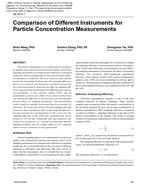Description
Particulate sampling plays a very important role in indoor air quality and occupational exposure assessments. Most of the sampling instruments are designed and calibrated at standard conditions, but in real applications, they are used under different atmospheric conditions. The error can be so large that the results are misleading. In this paper, the sampling efficiency theory was reviewed, and laboratory and field experiments have been performed to determine the effect of sampling efficiency on particulate measurements for different types of particle instruments: a laser particle counter (LPC) and an aerodynamic particle sizer (APS). It was observed that there was substantial difference in the measured size distributions between these two sampling instruments. The measurement results should be carefully interpreted based on principles of operation. The results also showed that the sampling tube and connectors had a significant effect on the sampling efficiency because of impaction and deposition. In the worst case, the sampling efficiency of the APS with a sampling tube can be reduced to 10% of that without any tube and connectors for certain size of particles. It is strongly recommended that the sampling methods and the sample efficiency be evaluated before tests are conducted in real applications.
Units: Dual
Citation: ASHRAE Trans. vol. 111, pt. 2, paper no. DE-05-3-1, p. 467-475
Product Details
- Published:
- 2005
- File Size:
- 1 file , 2.5 MB
- Product Code(s):
- D-26952




